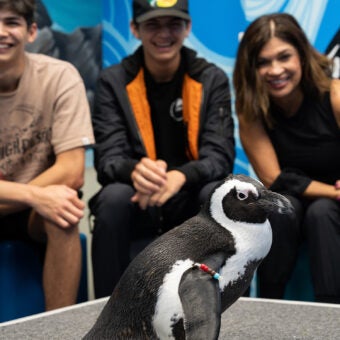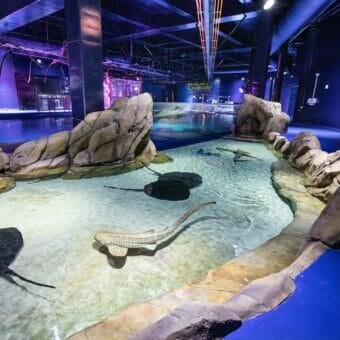-
Size
Up to 16 inches (41 cm) -
Diet
Zooplankton -
Range
Indo-Pacific -
Habitat
Sandy slopes
Physical Characteristics
- Has a whitish, snake-like body covered with yellow to orange colored stripes.
- Can grow to about 16 inches (41 cm) in length.
- Body diameter to about 0.4 inches (1 cm).
- Has large eyes and a small pectoral fin.
Animal Fact
Garden eels use their tails to dig burrows and will rarely leave.
Diet / Feeding
- Diet consists of zooplankton it picks from the current as it flows past. For this reason, all the eels in a colony generally face the same direction: into the current.
Range / Habitat
- Occurs in tropical Indo-Pacific waters near the Maldives, Philippines and Indonesia; possibly as far south as Fiji.
- Found along sandy slopes at depths of 60-265 feet (18-81 m), usually in depths of more than 100 feet (30.5 m).
- Lives in a sandy burrow that it digs tail-first. The garden eel then coats the sand walls with mucus from its body to cement the sand grains together to prevent collapse.
Reproduction & Growth
- Males and females move burrows to increase proximity during mating season.
- Will stretch from adjacent burrows and intertwine bodies to spawn.
- Males display protective behaviors toward their female mate, keeping other competitors away. They may bite rivals.
- Pelagic spawner: after mating, females will release fertilized eggs into the current.
- After the eggs hatch in the current, larvae continue to float until reaching a size threshold. At that point, juvenile garden eels will dig their own burrow.
Conservation Status
- “Least Concern” on the IUCN Red List.
Additional Information
- Also known as the “orange barred garden eel.”
- Live in colonies that can consist of thousands of individuals each occupying its own burrow.
- Most commonly seen with just its head and upper body extended out of the burrow, swaying in the current like a blade of seagrass in order to feed on passing plankton.
- Easily disturbed and quickly retracts itself, tail first, into its burrow.
- Rarely leaves its sand burrow, even to spawn.
- This species was discovered when SCUBA diving became popular.
Sources
- http://www.fishbase.org/summary/Gorgasia-preclara.html
- Reef Fishes, Michael, Scott W., pg. 287-288, 292






